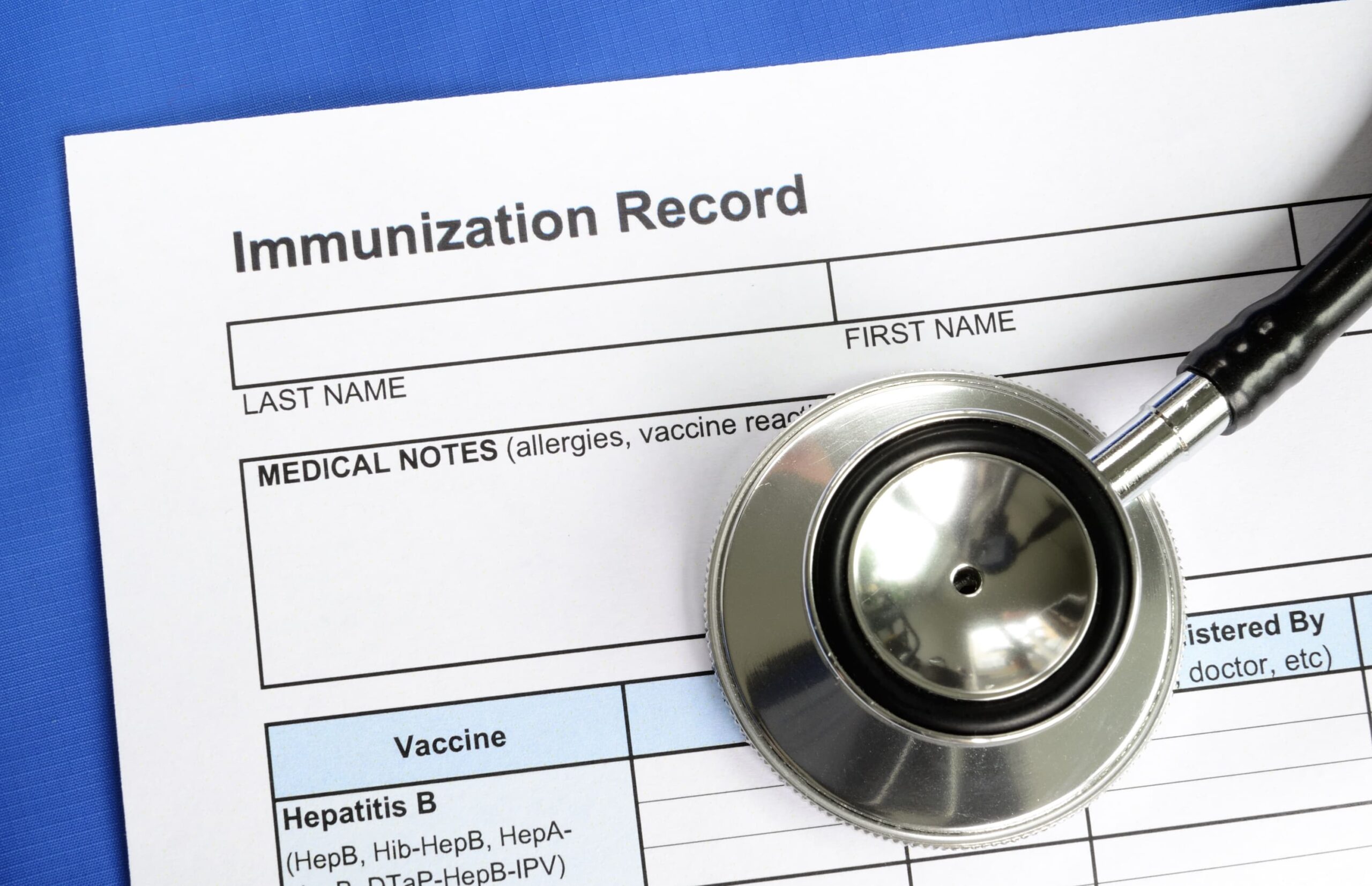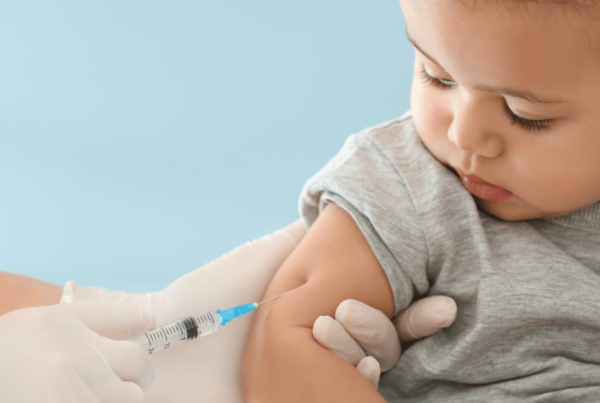Along with all the excitement and anticipation we experience during pregnancy can come some worry about all the decisions we need to make for our baby’s health and our own health, too. For Rh-negative mothers, this includes making informed decisions about the Rh immune globulin injection, commonly known as the RhoGAM shot.
This article shares pertinent information about the RhoGAM shot, including its benefits and risks, and details how the shot works and who should get it.
What Does it Mean to be Rh-Negative?
Everyone has a blood type that is either Rh-negative or Rh-positive. Those who are Rh-positive have the Rh factor — also known as the Rh antigen or D antigen — on the surface of their red blood cells. Those who are Rh-negative do not. The Rh factor is inherited. Being Rh-negative or Rh-positive doesn’t usually affect people in their day to day lives, but this distinction does matter during pregnancy as it can influence blood compatibility between a mother and her fetus.
Understanding Rh-Incompatibility & Rh-Sensitization
If the blood of an Rh-positive baby enters the bloodstream of an Rh-negative mother, then a blood type mismatch occurs. This is known as Rh-incompatibility.
 The mother’s immune system may then perceive the baby’s red blood cells as foreign invaders and produce antibodies to eliminate them, a process known as Rh-sensitization. Since this maternal immune response takes time to develop, it is harmless during a first Rh-incompatible pregnancy. However, once a mother has produced an immune response and become Rh-sensitized, all future Rh-positive fetuses are at risk for developing Hemolytic Disease of the Newborn (HDN). When given appropriately, RhoGAM will prevent a mother’s immune system from responding (1).
The mother’s immune system may then perceive the baby’s red blood cells as foreign invaders and produce antibodies to eliminate them, a process known as Rh-sensitization. Since this maternal immune response takes time to develop, it is harmless during a first Rh-incompatible pregnancy. However, once a mother has produced an immune response and become Rh-sensitized, all future Rh-positive fetuses are at risk for developing Hemolytic Disease of the Newborn (HDN). When given appropriately, RhoGAM will prevent a mother’s immune system from responding (1).
What is the RhoGAM Shot, and How Does it Work?
RhoGAM is an injectable immune globulin made from human blood plasma that prevents an Rh-negative mother from producing antibodies against Rh-positive fetal red blood cells (2). The RhoGAM shot is administered to Rh-negative pregnant women, and this is usually done both during and immediately after pregnancy (2). The purpose of the RhoGAM shot is to prevent sensitization, or the occurrence of a maternal immune reaction, and thereby safeguard future babies.
Prevention is achieved through the administration of passive anti-D antibodies (3). These antibodies neutralize any Rh-positive fetal red blood cells that enter the mother’s bloodstream before her immune system can recognize and react to them. By “masking” these cells, RhoGAM stops the mother’s immune system from perceiving the Rh-positive fetal blood cells as foreign and creating antibodies against them (3).
When is RhoGAM Typically Administered?
RhoGAM is routinely administered to all Rh-negative mothers during pregnancy and immediately postpartum. It is typically injected in the upper arm or buttocks around the 28th week of pregnancy, when the likelihood of fetal blood mixing with maternal blood begins to increase, and again within 72 hours after childbirth due to the possibility that fetal blood cells may have entered the maternal circulation during delivery (2).
RhoGAM is also recommended for Rh-negative women in the following scenarios (2):
- After childbirth, miscarriage, abortion, or ectopic pregnancy if the fetus is or was suspected to be Rh-positive.
- After invasive procedures that may cause fetal blood to mix with maternal blood.
What Ingredients Are in the RhoGAM Shot?
In the US, the trade name of the Rhogam shot is Rhophylac®, and it contains the following ingredients: a maximum of 30 mg/mL of human plasma proteins — 10 mg/mL of which is human albumin that is added as a stabilizer, 20 mg/mL of glycine, and up to 0.25 M of sodium chloride. Human albumin is manufactured from pooled plasma of US donors by cold ethanol fractionation, followed by pasteurization (4).
RhoGAM is made from human blood and may carry a risk of transmitting infections (4). However, the likelihood is rare, and the risk of developing Rh-sensitization is much higher than the risk of developing reactions from the RhoGAM shot. Once sensitization happens, all future pregnancies are at risk of a baby becoming very sick if Rh-positive.
How Do I Know If My Child’s Blood Type Is Incompatible With Mine?
As a fetus’s Rh status is not routinely checked during pregnancy — it requires an invasive procedure and the Rh-positive blood type is more common — standard of care involves giving the RhoGAM shot to all Rh-negative pregnant mothers. It is, however, possible to get an idea of whether your child’s blood type may be incompatible with yours. Doing so involves a few straightforward medical tests and a basic knowledge of genetics. If you are Rh-negative, there is a potential for Rh-incompatibility if your baby is Rh-positive.
 The first step in assessing this risk is knowing your own Rh status, which is typically determined early in pregnancy through routine blood tests. If you are Rh-negative, finding out the father’s Rh status can give clues about the possible Rh status of the baby. If the father is Rh-positive, there is a chance the baby could also be Rh-positive. If both parents are Rh-negative, the baby will also be Rh-negative, and there is no risk of Rh incompatibility. This is important, because simply knowing the fathers Rh status can rule out the need for the RhoGAM shot.
The first step in assessing this risk is knowing your own Rh status, which is typically determined early in pregnancy through routine blood tests. If you are Rh-negative, finding out the father’s Rh status can give clues about the possible Rh status of the baby. If the father is Rh-positive, there is a chance the baby could also be Rh-positive. If both parents are Rh-negative, the baby will also be Rh-negative, and there is no risk of Rh incompatibility. This is important, because simply knowing the fathers Rh status can rule out the need for the RhoGAM shot.
A more recent option for determining a baby’s Rh status prior to birth is noninvasive prenatal testing (NIPT), which can be done as early as the 10th week of pregnancy. This test analyzes fetal DNA in the mother’s bloodstream to determine the Rh status of the baby with high accuracy. However, this test might not be available in all areas and might not be covered by all insurances (5)
In cases where there is a need for detailed information, tests like amniocentesis or chorionic villus sampling (CVS) might be used, although these are generally performed for other reasons due to their invasive nature.
What is the Likelihood of My Blood Mixing with My Baby’s Blood During Pregnancy?
If you know that you are Rh-Negative and the baby’s father is Rh-Positive, there is a chance that your baby is Rh-Positive.
During a pregnancy without complication and after a straightforward birth, there is generally low risk of significant blood mixing between the mother and the baby. The placenta serves as a barrier that normally prevents large-scale mixing of maternal and fetal blood. However, certain conditions and events can increase the probability of blood mixing, which could lead to sensitization if not managed properly.
Situations that Increase the Risk of Blood Mixing:
- Childbirth: The most common time for Rh-positive fetal red blood cells to enter the mother’s bloodstream is during delivery. Even in uncomplicated deliveries, a small amount of fetal blood may mix with maternal blood.
- Miscarriage or Abortion: Any disruption in the pregnancy, such as a miscarriage or abortion, especially in the second trimester or later, can lead to mixing of fetal and maternal blood.
- Pregnancy Complications: Conditions like placental abruption (where the placenta detaches from the womb’s wall prematurely) or placenta previa (where the placenta covers the cervix) can cause bleeding, which increases the risk of blood mixing.
- Medical Procedures: Invasive procedures, such as amniocentesis (sampling of the amniotic fluid using a needle) or chorionic villus sampling (sampling of placental tissues for prenatal testing), inherently carry a risk of mixing fetal and maternal blood.
- External Trauma: Any abdominal trauma during pregnancy can disrupt the placenta and result in blood mixing.
Please note that as long as an Rh-negative mother receives RhoGAM appropriately during every pregnancy, her babies are at very low risk of developing complications. An Rh-negative pregnant woman should receive RhoGAM during every pregnancy unless her doctor has determined that she has already been sensitized or if her fetus is confirmed to be Rh-negative.
Rh-Related Complications
The administration of RhoGAM has significantly reduced the incidence of Rh-related complications, such as Hemolytic Disease of the Newborn (HDN) — a condition where the pregnant mother’s immune system attacks the fetus’s red blood cells (1). However, once a pregnant mother has produced an immune response, all future Rh-positive fetuses are at risk of developing HDN, a serious condition that may cause anemia, jaundice, heart failure, or brain damage.
Hemolytic Disease of the Newborn (HDN)
In future pregnancies, the antibodies previously formed by the mother can cross the placenta and attack the red blood cells of an Rh-positive fetus. This can lead to Hemolytic Disease of the Newborn, which ranges from mild to severe conditions including the following (6):
- Anemia: The destruction of red blood cells leads to anemia, where the blood lacks enough healthy red cells to carry adequate oxygen to the body’s tissues.
- Jaundice: The breakdown of red blood cells produces bilirubin. A high level of bilirubin can cause jaundice, which is characterized by a yellowing of the skin and eyes.
- Hydrops Fetalis: In severe cases, HDN can cause hydrops fetalis, a serious condition where the fetus develops severe swelling due to heart failure.
- Kernicterus: High levels of bilirubin can lead to a form of brain damage known as kernicterus, which can result in permanent neurological damage.
How is Hemolytic Disease of the Newborn Detected?
Hemolytic Disease of the Newborn can be detected in the following ways (7):
- Antibody Screening: During prenatal care, an antibody screen is performed to check whether the Rh-negative mother has developed antibodies against Rh-positive blood.
- Ultrasound and Blood Tests: In pregnancies at risk, regular monitoring through ultrasound and maternal blood tests can assess the health of the fetus, looking for signs of anemia or other complications.
The Management of Rh-Sensitized Pregnancies
Rh-sensitization during pregnancy doesn’t come with warning signs. A blood test is the only way to know if you are sensitized or at risk of becoming so. If it is determined that the mother is sensitized — she has developed an immune response against her fetus’s red blood cells — there are several ways in which this is managed to minimize risk to the fetus (8):
- Intrauterine Transfusions: In cases where the fetus is found to be severely anemic, intrauterine blood transfusions may be performed. This procedure involves transfusing Rh-negative blood directly to the fetus to treat anemia and reduce the risk of hydrops fetalis.
- Early Delivery: Depending on the severity of the condition and the gestational age, early delivery may be considered to manage the risks associated with severe anemia or hydrops fetalis.
- Postnatal Care: After birth, babies affected by HDN may require treatments (such as phototherapy to manage jaundice), additional blood transfusions, and close monitoring of bilirubin levels to prevent kernicterus.
Possible Risks & Side Effects of the RhoGAM Shot
RhoGAM is categorized as FDA Pregnancy Category C (9), indicating that while animal reproduction studies have shown an adverse effect on the fetus, the benefits may warrant its use despite potential risks. Known side effects include local swelling at the injection site, skin rash, and body aches (9). Despite its benefits, the use of RhoGAM is not without controversy.
Critics argue that the routine prenatal use of RhoGAM may be unnecessary, especially since the likelihood of sensitization during pregnancy is relatively low. Furthermore, concerns about the long-term effects of RhoGAM on children who are Rh-negative (who therefore do not need the protection) remain underexplored.
A middle ground approach is sometimes chosen, where the RhoGAM shot is applied only after childbirth, so the baby is unaffected; however, a postpartum shot does not offer protection during the pregnancy. Proponents are comforted by the knowledge that the risk of maternal-fetal blood mixing during pregnancy is relatively low and studies indicate that even just post-birth administration of the RhoGAM shot significantly reduces risks for future pregnancies (10).
Who Should Not Get The RhoGAM Shot?
RhoGAM should not be taken if a pregnant woman is Rh-positive, already Rh-sensitized, or she has previously had a severe allergic reaction to human immune globulin (7). RhoGAM should never be injected into a baby.
Making an Informed Decision About the RhoGAM Shot
For Rh-negative mothers, the decision to receive RhoGAM should be made after thorough consultation with healthcare providers, considering both the potential benefits and risks.
Summary
The RhoGAM shot is a preventative treatment given to Rh-negative mothers to avoid the production of antibodies that attack Rh-positive fetal blood cells, which can cause complications in future pregnancies. Rh factor is a protein on red blood cells: those without it are Rh-negative and can develop immune responses if exposed to Rh-positive blood, which can happen to an Rh-negative woman if she is carrying an Rh-positive fetus.
The RhoGAM shot, often administered as standard of care to Rh-negative mothers around the 28th week of pregnancy and after childbirth, works by providing passive anti-D antibodies that neutralize Rh-positive fetal blood cells before the mother’s immune system reacts, known as Rh-sensitization. It is possible to determine the fetal Rh status, which information can help parents make informed healthcare decisions.
References:
- Costumbrado J, Mansour T, Ghassemzadeh S. Rh Incompatibility. [Updated 2022 Dec 11]. In: StatPearls [Internet]. Treasure Island (FL): StatPearls Publishing; 2024 Jan-. Available from: https://www.ncbi.nlm.nih.gov/books/NBK459353/
- American College of Nurse-Midwives. (2013). Rh‐Negative blood type and pregnancy. Journal of Midwifery & Women’s Health, 58(6), 725–726. https://doi.org/10.1111/jmwh.13086
- ScienceDirect Topics. (n.d.). Rho(D) Immune Globulin – an overview. www.sciencedirect.com. Retrieved April 24, 2024, from https://www.sciencedirect.com/topics/immunology-and-microbiology/rho-d-immune-globulin
- Just the Inserts. (2021, October 15). Everything you need to know about RhoGAM. Retrieved April 24, 2024, from https://www.justtheinserts.com/rhogam/
- Health, A. G. D. of. (n.d.). 1574 – Non-Invasive Prenatal Testing (NIPT) for fetal Rhesus D genotype. www.msac.gov.au; Australian Government Department of Health. Retrieved April 24, 2024, from http://www.msac.gov.au/internet/msac/publishing.nsf/Content/1574-public
- Hall V, Avulakunta ID. Hemolytic Disease of the Newborn. [Updated 2022 Nov 22]. In: StatPearls [Internet]. Treasure Island (FL): StatPearls Publishing; 2024 Jan-. Available from: https://www.ncbi.nlm.nih.gov/books/NBK557423/
- Stanford Medicine Children’s Health. (n.d.). Hemolytic disease of the newborn (HDN). Retrieved April 24, 2024, from https://www.stanfordchildrens.org/en/topic/default?id=hemolytic-disease-of-the-newborn-hdn-90-P02368
- HealthLink BC. (n.d.). Rh Sensitization during pregnancy. Www.healthlinkbc.ca. Retrieved April 24, 2024, from https://www.healthlinkbc.ca/pregnancy-parenting/pregnancy/risks-and-complications-during-pregnancy/rh-sensitization-during
- Rhophylac® Rh0(d) immune globulin intravenous (n.d.) www.fda.gov. Retrieved April 24, 2024, from https://www.fda.gov/media/75013/download
- McBain, R. D., Crowther, C. A., & Middleton, P. (2015). Anti-D administration in pregnancy for preventing Rhesus alloimmunisation. The Cochrane database of systematic reviews, 2015(9), CD000020. https://doi.org/10.1002/14651858.CD000020.pub3








